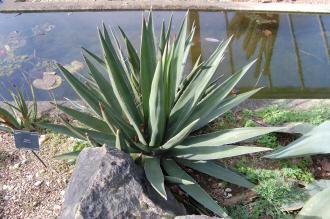
Agave difformis (28/02/2016, Kew Gardens, London)
Position: Full sun
Flowering period: Late spring to early summer
Soil: Moist, well drained
Eventual Height: 90cm
Eventual Spread: 120m
Hardiness: 8b, 9a, 9b, 10a, 11
Family: Asparagaceae
Sub Family: Agavoideae
Agave difformis is an evergreen, rosette forming perennial shrub. Its fleshy grey/ green leaves are lanceolate with spiny margins and an acuminate tip, up to 60cm long and 6cm across. It leaves are arranged in a rosette. Its yellow/ green flowers appear on a flower spike which may be up to 5m tall. Each plant flowers once after which it dies. It produces rhizome like offsets which helps the spread of this plant. Its root system is shallow and fibrous.
Agave difformis, commonly known as Deformed Century Plant, is native to north central Mexico. In its native habitat it grows in sandy/ rocky soils in desert condition in grasslands at an elevation of 1,600m to 1,900m.
The etymological root of the binomial name Agave is derived from Greek mythology being the daughter of Cadmus, who supposedly founded the city of Thebes. Difformis is derived from the Latin difformatas meaning ‘lack of uniformity’, in reference to its leaves.
The landscape architect may find Agave difformis useful as a dramatic specimen plant. Once established this plant is drought tolerant. This plant may be growing as a houseplant providing sufficient light and room are given, it should be noted its leaf tips have sharp spines. It would be suitable for conservatory or atrium type conditions.
Ecologically, Agave difformis flowers are attractive to nectar loving birds and pollinating insects.

Agave difformis Leaf (28/02/2016, Kew Gardens, London)
Agave difformis prefers moist, well-drained soils. It tolerates most pH of soil. It will tolerate poor soils.
When maintaining Agave difformis as a houseplant its soil should be watered sparingly. Watering should be reduced during the winter months. Its preferred active growing temperature rages from between 14ºc to 24ºc, although it will tolerate a temperature below freezing. Feeding with weak fertiliser solution should be carried out once a month during the growing season.

Landscape Architecture

